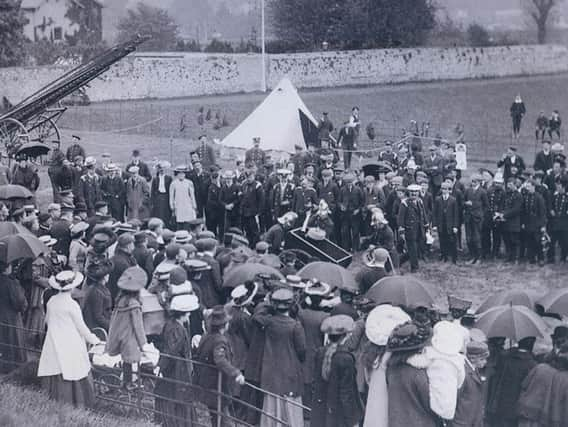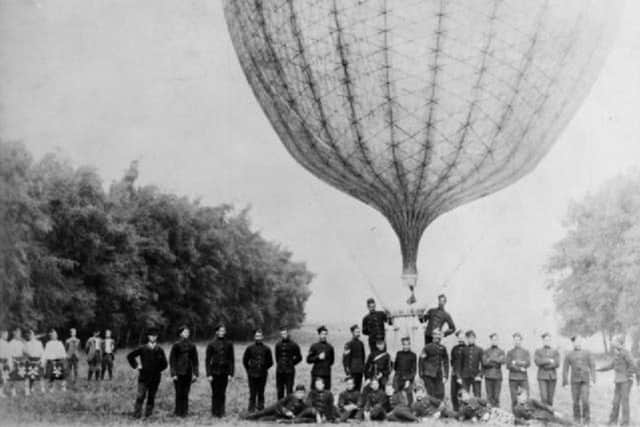Fiery end for Dripping Pan's Crimean War peace balloon


Russia was deemed to have lost the war and the ending of hostilities led to widespread celebrations in England.
A public holiday was declared for 29th April of that year. We have a description of how the day was marked in Lewes: “The shops were all closed and a large flag was hung across the centre of the High Street, with the word ‘Peace’ inscribed thereon. The arrangements were that the children of respective parishes should assemble and walk in procession to the Corn Exchange, where a dinner would be provided, after which a monster procession was to be formed to parade through the town and proceed to the Dripping Pan, where a variety of sports were provided.
Advertisement
Hide AdAdvertisement
Hide Ad“Unfortunately, however, the weather, which up to about noon had been most brilliant, suddenly changed, and a heavy thunderstorm took place, the rain falling in torrents till about four o’clock, when the rain ceased, and the remainder of the afternoon and evening were comparatively fine.


“Dinner being concluded, and the rain still continuing, the tables were removed in the Corn Exchange and various amusements were provided till four o’clock, when it was determined to proceed to the Dripping Pan. The monster procession was accordingly formed, the girls passing out at the front entrance and the boys at the side entrance, small flags being distributed among them at regular intervals. The procession was headed by an excellent German band from Hastings that was followed by the Lewes Old Band.
“Having proceeded to the Dripping Pan, each child received a bun and an orange and sports of all kinds were indulged in, such as stoolball, bat and trap and other games. A large balloon had been prepared, but unfortunately it caught fire as it was about to be started. A display of fireworks terminated the proceedings of the day.”
One must presume that the balloon was a hot air one and that the fire was a result of over-enthusiastic application of the flames needed to generate the heat that would inflate the envelope and make it rise.
Advertisement
Hide AdAdvertisement
Hide AdLewes today retains two tangible links to the Crimean conflict. Firstly there is an impressive monument in the churchyard of St John sub Castro. It commemorates 28 Finnish sailors who died of wounds or sickness while being held as prisoners of war in the nearby naval prison. Finland was part of the Russian empire at the time and the men had been captured in sea skirmishes in the Baltic; by all accounts they were not treated harshly and were given parole so that they were free to wander around Lewes in the daytime. There is also a captured Russian cannon from the Crimea displayed in the Gun Garden of Lewes Castle.


Other Sussex connections include Martin Leonard Landfried. His trumpet call signaled the start of the unbelievably brave but most unwise Charge of the Light Brigade at Balaclava on 25th October 1854. He is buried in Hove Cemetery. Another survivor of the war is buried in West Chiltington; George Johnson’s headstone bears the words “Crimean Veteran”.
The Crimean War saw the first awards of the Victoria Cross after it was introduced in 1856 to recognize conspicuous gallantry “in the face of the enemy”. The metal from which the medals are fashioned is derived from two cannons that were captured from the Russians during the siege of Sevastopol.
An early recipient of the honour was Lieutenant-General Sir Wilbraham Oates Lennox. He was born in Goodwood, West Sussex, and was a first cousin to the ancestors of the present-day Earl of March. On 20th November 1854 Lennox was 24 years old and a lieutenant in the Corps of Royal Engineers when he won his VC at Sevastopol. The citation recorded: “He led 100 men into rifle-pits which had just been captured from the enemy, and despite extreme exposure to attack, managed to maintain the position through the night.”
Advertisement
Hide AdAdvertisement
Hide AdLennox remained with the British army in the Crimea until it re-embarked in June 1856. He subsequently served in India during the Mutiny and was present at the relief of Lucknow. During the Franco-Prussian War (1870-71) he was an observer with the German army and served as a military attaché with Ottoman troops during the Russo-Turkish War (1876-78). He commanded the British garrison at Alexandria (1884), troops in Lower Egypt (1885-86) and also on the Indian Ocean island of Ceylon (1887-88). He was made a Companion of the Bath in 1867 and a Knight Commander of the Bath in 1891.
Lennox proved particularly proficient in hunting big game while stationed in Ceylon (present day Sri Lanka) where he shot no less than 100 elephants. My initial shock at reading this bloody statistic was tempered when I learnt that the country’s wild elephants were so destructive of agriculture that the government offered a reward for every one that was culled.
In later life Lennox journeyed extensively in Palestine and also travelled around the world. He was married twice and had a total of seven children.
General Sir Wilbraham Oates Lennox died on 7th February 1897 in London’s Pimlico. He was buried in the family plot in the cemetery off Lewes Road in Brighton.